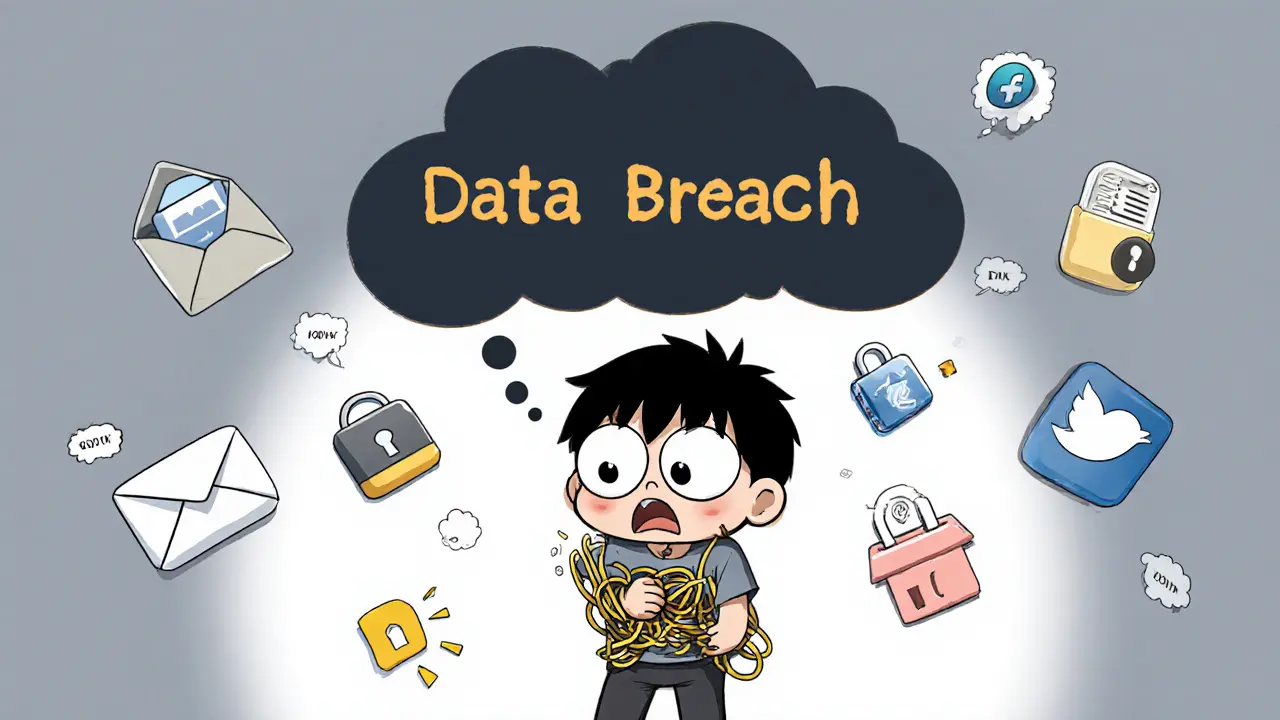Decentralized Identity Comparison Tool
This interactive tool helps you understand the key differences between traditional centralized identity systems and modern decentralized identity approaches.
Traditional Identity
Centralized systems where identity data is stored in a single location controlled by an organization. Users rely on usernames and passwords managed by service providers.
Decentralized Identity
User-controlled identity using cryptographic keys and distributed ledgers. Users own their identity data without relying on a central authority.
| Aspect | Centralized Identity | Decentralized Identity |
|---|---|---|
| Data Storage | Single provider holds all personal data. | Data stays in user’s wallet; only public keys on ledger. |
| Privacy | Broad data sharing; limited user control. | Selective disclosure via ZKP; minimal exposure. |
| Breach Impact | One breach leaks millions of records. | No central repository; breach scope limited to individual wallets. |
| User Experience | Multiple passwords, frequent resets. | Single wallet, but requires key management knowledge. |
| Interoperability | Vendor-specific APIs. | W3C standards (DID, VC) foster cross-platform use. |
- Stronger Privacy ✓
- Reduced Breach Risk ✓
- Single-Sign-On Across Services ✓
- Portability ✓
- User Control ✓
- Usability Complexity ✗
- Wallet Recovery ✗
- Ecosystem Adoption ✗
- Regulatory Uncertainty ✗
- Performance Limitations ✗
Did You Know?
Decentralized Identity is built on three core components:
- Decentralized Identifiers (DIDs): Unique identifiers stored on a blockchain
- Verifiable Credentials (VCs): Tamper-evident digital certificates
- Digital Wallets: Secure containers for storing keys and credentials
These technologies work together to give you control over your digital identity without relying on centralized authorities.
Ever felt annoyed by having to create a new username and password for every online service, then wonder why a single data breach can expose all your personal info? decentralized identity aims to end that frustration by letting you own and control your digital credentials without a central authority holding your data.
TL;DR
- Decentralized Identity Management (DIM) lets users control their identity via cryptographic keys, not centralized databases.
- Core building blocks: Decentralized Identifiers (DIDs), Verifiable Credentials (VCs), and digital wallets.
- Benefits include stronger privacy, reduced breach risk, and single‑sign‑on across services.
- Challenges are user‑experience complexity, wallet recovery, and ecosystem adoption.
- Key players: W3C (standards), Trust Over IP Foundation (DID methods), and emerging SSI platforms.
What is Decentralized Identity Management?
Decentralized Identity Management is a framework that shifts identity control from centralized providers to the individual, using cryptographic keys and distributed ledgers. It eliminates the need for a single issuer to store personal data, instead letting users prove who they are with digitally signed attestations.
Think of it as a passport that lives in your phone: you decide which pages to show to an airline, a hotel, or a bank, and no government agency or corporation holds a master copy.
Key Components of a Decentralized Identity System
Decentralized Identifier (DID)
DID is a globally unique, cryptographically verifiable string that represents an identity without revealing personal data. A DID looks like did:example:123456789abcdefghi where the method ("example") tells the network how to resolve the identifier.
DIDs are stored on a blockchain or other distributed ledger, providing an immutable anchor point for the identity.
Verifiable Credential (VC)
Verifiable Credential is a tamper‑evident digital certificate issued by a trusted party (university, government, employer) and signed with the issuer’s private key. VCs contain claims such as "John Doe holds a Bachelor’s degree in Computer Science" and can be selectively disclosed using zero‑knowledge proofs.
Digital Wallet
Digital Wallet is a secure software container that stores a user’s private keys, DIDs, and VCs. The wallet creates cryptographic proofs on‑the‑fly, allowing the holder to prove attributes (age, citizenship) without exposing the full credential.
Self‑Sovereign Identity (SSI)
Self‑Sovereign Identity is a subset of decentralized identity where the user has full ownership, control, and portability of identity data. SSI systems adopt the same DID‑VC model but emphasize user‑centric consent flows and data minimization.
Underlying Technology: Blockchain
Blockchain acts as the immutable ledger that records DIDs and, optionally, proof of credential revocation. While most credential data lives off‑chain in wallets, the public key and revocation status stay on‑chain, guaranteeing trust without a central server.
Zero‑Knowledge Proofs (ZKP)
Zero‑Knowledge Proof is a cryptographic method that lets a user prove a statement (e.g., "over 18") without revealing the underlying data. ZKPs enable privacy‑preserving verification, a cornerstone of SSI.
Standard‑Setting Bodies
The W3C maintains the DID and VC specifications, ensuring cross‑platform interoperability. The Trust Over IP Foundation catalogs DID methods and provides reference architectures for enterprise adoption.
How a Decentralized Identity Transaction Works
- Issuer creates a VC. A university signs a degree credential with its private key and uploads the VC to the graduate’s wallet.
- Holder stores the VC. The graduate’s digital wallet keeps the credential encrypted, along with the associated DID.
- Verifier requests proof. An employer asks "Is the candidate over 21?" and receives a ZKP request.
- Holder generates proof. The wallet uses the VC and private key to produce a cryptographic proof that satisfies the request without revealing the birthdate.
- Verifier validates proof. Using the issuer’s public key (retrieved via the DID document on the blockchain), the verifier checks the signature and confirms the claim.
This flow eliminates the need for the employer to call the university’s database, reducing latency and exposure of personal data.

Benefits Over Traditional Centralized Identity
| Aspect | Centralized Identity | Decentralized Identity |
|---|---|---|
| Data Storage | Single provider holds all personal data. | Data stays in user’s wallet; only public keys on ledger. |
| Privacy | Broad data sharing; limited user control. | Selective disclosure via ZKP; minimal exposure. |
| Breach Impact | One breach leaks millions of records. | No central repository; breach scope limited to individual wallets. |
| User Experience | Multiple passwords, frequent resets. | Single wallet, but requires key management knowledge. |
| Interoperability | Vendor‑specific APIs. | W3C standards (DID, VC) foster cross‑platform use. |
In practice, this means you can log into a new app with the same wallet you use for your university diploma, without the app ever seeing your email address or phone number.
Challenges and Adoption Barriers
While the promise is appealing, real‑world rollout faces several hurdles:
- Usability. Non‑technical users must understand key backup, seed phrases, and wallet recovery-concepts foreign to most consumers.
- Recovery Mechanisms. Losing a private key means losing access to all credentials. Solutions like social recovery or multi‑sig custodians are still experimental.
- Ecosystem Support. Verifiers need to integrate DID resolution and ZKP verification libraries, which adds development overhead.
- Regulatory Uncertainty. Data‑protection laws (GDPR, CCPA) were written around centralized controllers; applying them to self‑sovereign models raises legal questions.
- Performance. Blockchain writes can be costly and slow; many implementations store only hashes on‑chain to mitigate this.
Addressing these pain points is the focus of most current research and pilot programs.
Real‑World Use Cases
Several industries already experiment with decentralized identity:
- Travel. Airlines test DIDs for boarding passes, allowing travelers to share only flight eligibility without exposing passport numbers.
- Education. Universities issue digital diplomas as VCs; graduates present them to employers without handing over transcripts.
- Healthcare. Patients use wallets to prove insurance coverage or vaccination status without revealing full medical records.
- Finance. Banks accept ZKP‑based proof of address, cutting down KYC onboarding time.
- IoT. Devices authenticate to networks using device‑specific DIDs, enabling secure, password‑less connections.
These pilots demonstrate that once the user‑experience gaps shrink, the model scales across sectors.
Future Outlook (2025‑2027)
Industry analysts predict three trends that will shape the next wave of decentralized identity:
- Standard Consolidation. W3C’s DID and VC specifications will converge with emerging EU eIDAS‑compatible frameworks, easing cross‑border compliance.
- Layer‑2 Scaling. Rollup solutions on Ethereum and dedicated identity blockchains (e.g., IOTA Identity) will cut transaction fees below $0.01, making mass adoption financially viable.
- User‑Centric Recovery. Multi‑party social recovery and biometric‑linked wallets will lower the barrier for everyday consumers, turning key‑management into a background process.
When these pieces click, the vision of a single, portable digital identity that works everywhere becomes realistic.
Getting Started: A Quick Checklist
- Choose a reputable digital wallet that supports DID method you prefer (e.g., did:ethr, did:key).
- Back up your seed phrase in at least two offline locations.
- Identify issuers you trust (government, university) and request VCs in the wallet.
- Test a verifier that accepts ZKP (many blockchain‑based demo apps exist).
- Stay updated on W3C DID/VC version changes - they evolve yearly.
Following this checklist gets you into the decentralized identity ecosystem without a PhD in cryptography.

Frequently Asked Questions
What is the difference between a DID and a traditional username?
A DID is a cryptographic identifier that links to a public key and a DID document on a blockchain. It contains no personal data, cannot be taken down by a single provider, and can be rotated or revoked without losing the underlying identity. A username is just a human‑readable label stored in a central database and can be changed or deleted by the service owner.
Can I use a decentralized identity for logging into Facebook or Google?
Currently, major platforms have limited support for DIDs, but pilot programs exist. Some decentralized‑login bridges let you authenticate with a wallet and then receive a temporary token for Facebook or Google. Full native integration is expected as standards mature.
What happens if I lose my private key?
Losing the private key means losing access to all credentials tied to that DID. Recovery options include:
- Social recovery: a pre‑selected group of contacts can re‑authorize a new key.
- Hardware backup: store the seed phrase on a secure hardware device.
- Multi‑signature wallets: require multiple keys to act, reducing single‑point loss.
Are decentralized identities compliant with GDPR?
GDPR’s “right to be forgotten” is tricky for immutable ledgers. However, since PII is kept off‑chain in wallets, a user can delete the local data, effectively erasing personal information while the DID itself (a pseudonymous address) remains on the blockchain, which is permissible under GDPR as long as no personal data is stored there.
Which blockchain is best for identity projects?
It depends on your priorities:
- Ethereum (did:ethr) offers strong security and large developer community.
- Hyperledger Indy is purpose‑built for identity with native DID support.
- IOTA Identity provides feeless transactions and IoT focus.
- Bitcoin’s Taproot can host simple DIDs but lacks native credential features.







Jayne McCann
June 14, 2025 AT 17:08Decentralized identity sounds like another hype cycle that will fade.
Richard Herman
June 16, 2025 AT 19:08The shift from password farms to cryptographic wallets does cut down credential fatigue, and the zero‑knowledge proof tech really does let you prove something without spilling the beans. It also means services no longer need to store your personal data in massive databases. This reduction in data hoarding can lower the surface area for large‑scale breaches.
Stefano Benny
June 18, 2025 AT 21:08From a DID‑centric perspective, the credential stack leverages verifiable presentations (VP) atop decentralized identifiers, enabling selective disclosure via zk‑SNARKs 🚀.
The interoperability layer aligns with W3C specs, so cross‑domain federation becomes feasible.
Moreover, the underlying blockchain anchor provides tamper‑evidence without sacrificing user privacy.
Bobby Ferew
June 20, 2025 AT 23:08While the reduction in password fatigue is noted, the underlying key‑management overhead still scares the average consumer.
celester Johnson
June 23, 2025 AT 01:08One might argue that identity, in its essence, is a narrative we project onto a cryptographic substrate, and the current implementations merely digitize that age‑old saga.
Prince Chaudhary
June 25, 2025 AT 03:08If you’re curious, start by installing a wallet that supports did:ethr and request a test credential from a university that participates in the pilot program.
John Kinh
June 27, 2025 AT 05:08Sure, but the real‑world wallets still feel clunky 😒.
Mark Camden
June 29, 2025 AT 07:08Decentralized identity, when evaluated through a rigorous security lens, presents a paradigm shift that challenges entrenched data‑centralization models.
By anchoring identifiers on immutable ledgers, the probability of unilateral data exfiltration diminishes dramatically.
Furthermore, the cryptographic separation of authentication and authorization permits granular consent without exposing ancillary attributes.
This architectural nuance directly addresses the principle of data minimization championed by modern privacy regulations.
In practice, a verifiable credential issued by a university can be presented to an employer, who validates the signature against a DID document retrieved from the blockchain.
The employer never witnesses the underlying transcript, thereby preserving the graduate’s educational privacy.
Equally important is the potential for credential revocation, which can be broadcast via on‑chain status flags, mitigating the risk of stale or compromised attestations.
From a usability standpoint, the single‑wallet model reduces password fatigue, albeit at the cost of introducing key‑backup responsibilities.
Key recovery mechanisms, such as social recovery or multi‑signature escrow, are emerging but remain experimentally validated.
Regulatory bodies, including the EU’s eIDAS framework, are currently drafting interoperability guidelines that acknowledge decentralized identifiers.
These guidelines aim to reconcile the immutable nature of blockchains with the right‑to‑be‑forgotten provisions of GDPR.
Technical solutions, such as storing personal data off‑chain while keeping only hashes on‑chain, already demonstrate compliance pathways.
Economic analyses indicate that reducing central breach liabilities can translate into multibillion‑dollar savings for enterprises.
Nonetheless, the initial integration costs for developers, who must implement DID resolution and zero‑knowledge proof verification libraries, are non‑trivial.
Adoption incentives, such as reduced onboarding friction for end‑users, may offset these upfront expenditures over time.
In summary, while decentralized identity is not a panacea, its strategic benefits merit serious consideration by any organization seeking resilient, privacy‑preserving authentication.
Nathan Blades
July 1, 2025 AT 09:08That comprehensive breakdown hits the nail on the head; the security upside is undeniable, and the economic argument makes the tech more than just a buzzword.
Somesh Nikam
July 3, 2025 AT 11:08Indeed, the cost‑benefit matrix swings favorably once the initial developer effort is amortized, and the added user trust can be a decisive market differentiator :)
Jan B.
July 5, 2025 AT 13:08The integration path is clearer now, thanks.
MARLIN RIVERA
July 7, 2025 AT 15:08The hype over zk‑proofs ignores the reality that most users will never understand them, making the whole system a black box.
Courtney Winq-Microblading
July 9, 2025 AT 17:08Imagine a world where the passport in your pocket whispers only what you allow, refusing the prying eyes of faceless corporations.
katie littlewood
July 11, 2025 AT 19:08When we contemplate the broader societal canvas, decentralized identity emerges as a catalyst for digital sovereignty, granting individuals the reins over their own narrative.
It dismantles the monopoly of megacorporations that have long hoarded identity data like treasure chests.
The ripple effects extend to cross‑border commerce, where a single verifiable credential can smooth customs clearance without endless paperwork.
Moreover, in the realm of education, students can showcase micro‑credentials harvested from diverse MOOCs, all validated by a wallet that never sleeps.
From a philosophical standpoint, we are inching toward a post‑identity era where the self is defined by consensual attestations rather than static records.
Yet, this brave new world also demands robust education initiatives to prevent a divide between the crypto‑savvy and the tech‑naïve.
Governments, too, must grapple with the tension between oversight and empowerment, carving regulations that protect without stifling innovation.
In the end, the promise lies not merely in technology but in the collective will to re‑imagine trust.
Jenae Lawler
July 13, 2025 AT 21:08From a sovereign standpoint, the proliferation of borderless identity solutions threatens the intrinsic jurisdictional authority of nation‑states, potentially eroding the very fabric of regulated citizenship.
Chad Fraser
July 15, 2025 AT 23:08Give it a shot, the learning curve flattens once you get the hang of the seed phrase.